The first sight of a Large Dark Olive (Baetis Rhodani) drifting downriver, drying its wings, is heart-warming as it signals spring has arrived or is near.
This early season up-winged fly starts hatching on the Welsh Dee during March. However, after a mild winter, they are seen on mild-February days whereas, after a severe, late winter, it can be April before significant numbers of LDO hatch.
Late or early, their appearance it’s a welcome sight because it provides an opportunity to start dry fly fishing for trout or grayling, especially after spending the winter euro nymphing for grayling.
Habitat & lifecycle of the Large Dark Olive (LDO)
The LDO (also known as the winter olive) is found throughout the UK but only in running water. It flourishes in all types of running water from fast-flowing mountain streams to slow rivers, including weedy, chalk, and limestone rivers.
LDO’s begin to emerge in late February on the Welsh Dee, with the main hatch occurring in spring (March & April). After sporadic hatches throughout the summer, a secondary hatch occurs in autumn (September and October).
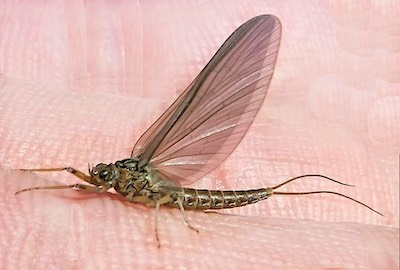
Usually, the best hatches of this hardy up-winged olive occur on dull, cool days, but I’ve witnessed some good hatches when there is snow on the ground.
On warm and windy days, newly hatched flies quickly leave the water because the dry conditions almost instantaneously dry their wings. In this situation, often, trout and grayling focus on taking the ascending nymphs.
The lifecycle of the large dark olive is similar to that of other up-winged flies:
- The nymph crawls out from its underwater habitat and swims to the surface (usually between 11 am and 4 pm).
- At the surface, nymphs emerge from their shuck and transform into duns.
- Duns sit on the surface while their wings dry and then fly off to find cover and mature into a spinner.
- In the evenings, adult male & female spinners mate. The females then land on semi-submerged rocks and bankside vegetation to crawl down into the river to lay their eggs.
Often, you can…
set your watch by the start of the LDO hatch
Usually, the hatch will begin slowly around 11 – 12 pm, gradually increase to a peak between 1 – 2 pm, and then peter out by about 3 pm. In warmer weather, the hatch will start earlier and finish later.
Large Dark Olive Nymph
The LDO nymph is torpedo-shaped (ca. 10 – 13mm long) with tails and belongs to the order of agile darters. It has a dark olive body with pale yellow ribs and darker wing buds, which become almost black when it’s ready to hatch.

Trout and grayling feed on the nymphs all year as they dart between rocks and weeds on the riverbed. However, spring hatches can send…
hungry, overwintered brown trout into a feeding frenzy.
Fishing Large Dark Olive nymph patterns:
While waiting for a hatch to start, I often fish a pheasant tail nymph pattern in the riffles & pool heads.
A slimly dressed pheasant tail nymph (size 14) is probably the best imitation of the LDO nymph because it has stood the test of time. (NB. Buy flies that have a thin body profile ca. 3 mm max).
So, what nymph patterns do I use?
Frank Sawyer’s Pheasant Tail Nymph is first up because…
- It catches fish
- Only two materials are required: copper wire and a pheasant tail feather
- Easy to tie – especially if you are starting fly tying.
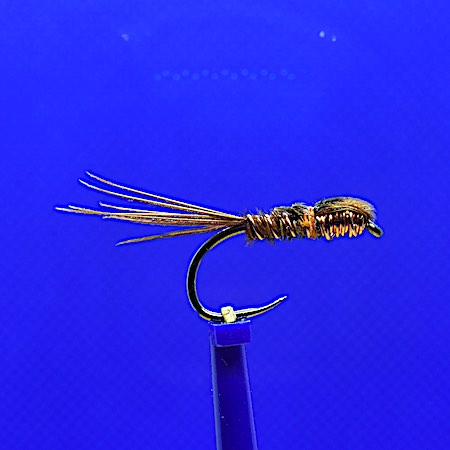
Frank Sawyer’s Pheasant Tail Nymph
- Hook – HENDS BL354 #12 to16
- Thread – Fine copper wire
- Tail – 4 to 5 pheasant tail fibres
- Body – 3 pheasant tail fibres
- Thorax – Fine copper wire
- Wing case – 5 pheasant tail fibres
This nymph is a good choice for streamy water.
However, for slower flowing water, where trout and grayling are selectively feeding, I use a more life-like large dark olive pattern that has legs.`It is more complex to tie but worth the additional effort. I always carry a few in my fly box for the occasions when Sawyer’s PTN does not work.
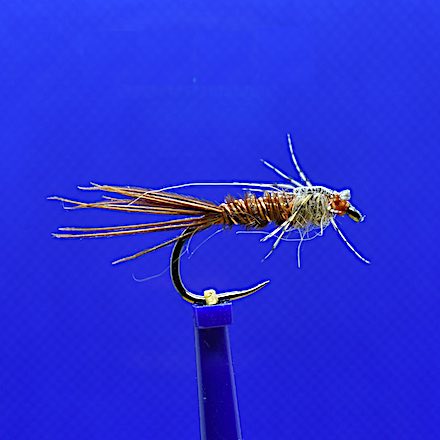
PL Pheasant Tail Nymph
- Hook – HENDS BL354 (#12 to 16)
- Thread – Tan 8/0 Uni
- Tail – pheasant tail fibre tips
- Body – pheasant tail fibres
- Rib – fine copper wire
- Thorax – Hare’s Ear dubbing
- Legs – Partridge neck feather
- Wing case – WASPI Mottled Oak Thin skin
In fast streamy water, use a heavier pattern to reach fish nymphing close to the riverbed. In that situation, I fish a pheasant tail jig nymph sporting a heavy tungsten bead.
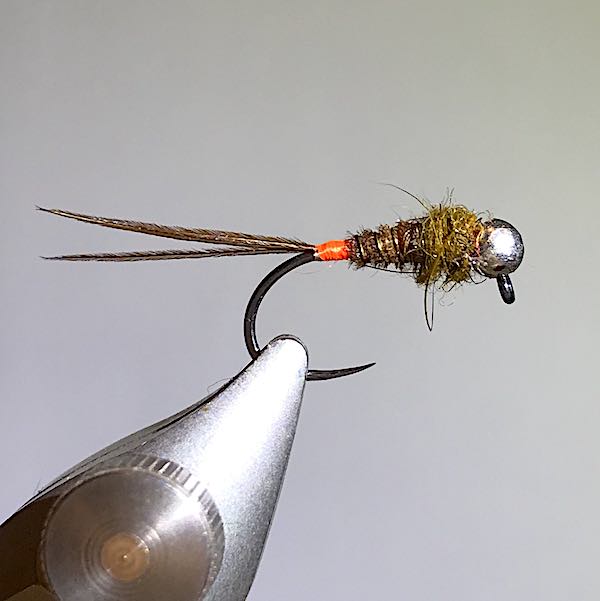
Pheasant Tail Jig Nymph
- Hook – HENDS BL154 (#12 & 16)
- Bead – 2.5mm tungsten (silver & gold)
- Thread – Brown UNI-Thread 8/0
- Tail – 3 pheasant tail fibre
- Tag – Orange floss (optional)
- Body – pheasant tail fibres
- Rib – Fine copper wire
- Thorax – Olive dubbing
It’s a versatile pattern, which I tie with, and without the orange tag and using a range of coloured tungsten beads (i.e. neutral, silver, gold, and copper).
Large Dark Olive Dun
Identification is easy because, apart from the March Brown, the LDO is often the only fly on the river at the start of spring. Also, the two species differ in both size and wing colouration.
The LDO has a dark olive-brown body (ca. 10mm long) with yellow-olive bands, which is roughly 3/4 the size of the March Brown. However, wing colouration is a more noticeable difference between the two species. The LDO has pale grey wings with brown veins, while March Brown has mottled brown wings.
Fishing for trout feeding on LDO
LDO nymphs start to swim to the surface to hatch into a dun between 10 and 11 am. During the hatching process, it unfolds its wings and floats on the surface while drying its wings, which can be slow during cold, damp conditions. During which time they are…
“Sitting Ducks”
Fish take the nymph as it emerges or while it’s waiting for its wings to dry. If your dry fly should start to sink, wait a few seconds before recasting because fish often take the drowning fly.

Often the best hatches of LDO occur at the heads of pools, fed by oxygenated water from gravel and rocky riffle sections. On the Welsh Dee, examples include:
Studying the general structures of the pools above gives the novice angler a clear understanding of what to look for on other rivers.
Wet fly/spider fly fishing
In spring, I aim to be fishing by 10 am to ensure I don’t miss the start of the large dark olive hatch. Also, I like to make the most of these short spring days because they often involve a 2-hour round-trip drive to the river for me.
I’m always eager to wet a line and often start fishing with a team of wet flies or North Country spiders. Usually, this approach catches a few trout before LDO start fluttering off the river, and I switch to dry fly fishing.
My standard wet fly cast consists of a team of 3 flies spaced 3ft apart on a 3 lbs copolymer leader (point fly – #14 pheasant tail nymph; middle dropper – #14 pearly-butt Bloa; to dropper – #14 pearl-ribbed March Brown spider).
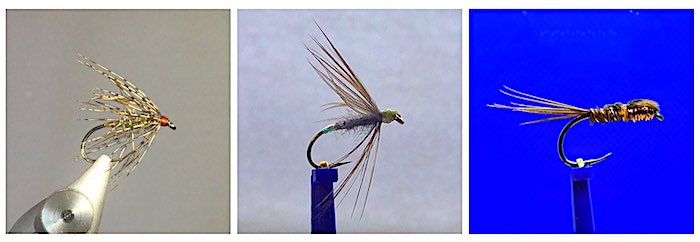
This team fished upriver is often deadly during the early stages of a hatch of large dark olives, especially when trout are taking the emerging insects and seem to be ignoring the flies drying their wings on the surface.
When there’s an intense hatch of LDO leaving the water almost immediately after emerging, fishing this team of flies can sometimes be better than the dry fly.
If you are not comfortable fishing a team of wet flies, start by fishing a single PRMB spider. If no takes come after 10 to 15 minutes, change the fly to a pearly-butt Bloa.
The pearly-butt Bloa and sparsely tied PRMB spider are highly effective imitations of olives – as such, there’s always some in my fly box.
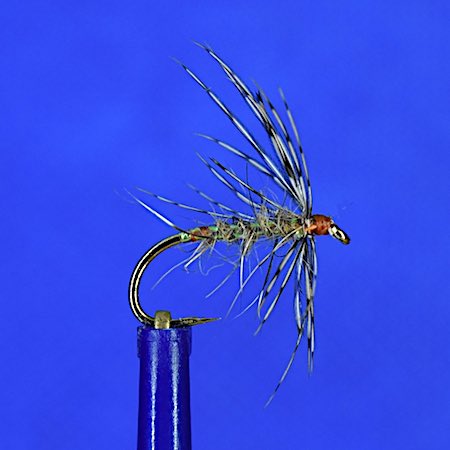
Pearl-ribbed March Brown Spider
- Hook: Kamasan B170 #14
- Body: Tan UNI-Thread 8/0
- Rib: Pearl Mylar #14 (1/32)
- Hackle: Brown partridge neck
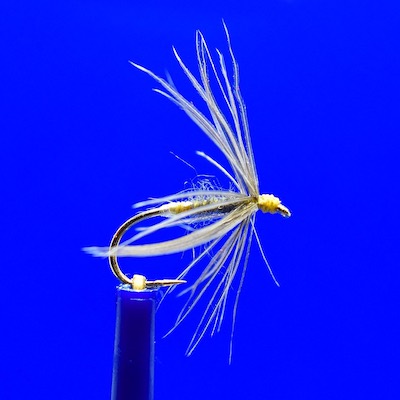
Pearly butt Watehen Bloa
- Hook: Kamasan B170 #14 & #16
- Thread: waxed primrose silk
- Body: lightly dubbed mole fur
- Hackle: Waterhen wing slip
Dry fly fishing
Spring is a civilized time of the year for the dry fly fishing pursuit because the LDO is a late riser, with hatches rarely starting before 11 am and over by 4 pm.
No early start or late finish on the river is required.
Overwintered, hungry trout waste little time intercepting large dark olives as they appear on the water, triggered by a subtle rise in air temperature.
Hatches range widely, from a stop-start affair to a constant stream with an intensity ranging from a small flurry to a blizzard of duns coming off the water. Also, the hatch can be very localized, with the pool alive with hatching duns while the next pool is dead.
Therefore, it is best to cover as many pools as possible in search of a hatch and rising trout. Once found, fish the pool thoroughly until it’s exhausted and then move on to a new location.
It’s always wise to avoid spooking rising trout, but presenting a dry fly to hungry brown trout is often straightforward. Even a…
Poorly presented fly is engulfed as it passes overhead.
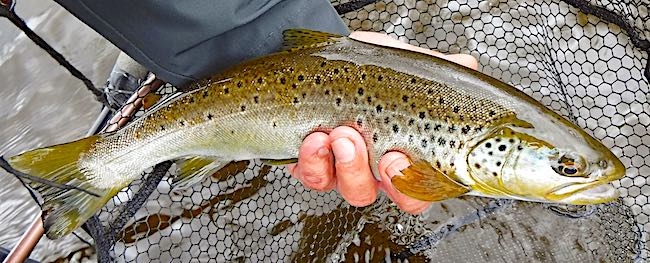
A simple dry fly leader set-up is often sufficient at this time of year. I use a 9ft 4X tapered copolymer leader with 2-3ft of 3lb fluorocarbon tippet tied onto the end.
Now, let’s take a look at fly choice…
Large Dark Olive dry fly patterns
Fortunately, a multitude of dry fly patterns is not required to successfully imitate the LDO. I’ve caught plenty of trout and grayling using three fly patterns that are relatively easy to tie.
In early spring, the Jingler fly is my preferred dry fly pattern, which is successful in slow to fast water. It will also take trout when allowed to swing around in the current.
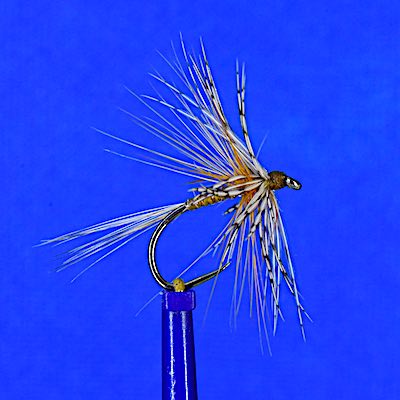
Jingler
- Hook: Kamasan B170 #14 & 12
- Thread: Olive 8/0 Uni
- Tails: Badger cock fibres
- Body: Hends body quill BQ-32
- Hackles: grey partridge & ginger cock
The front partridge feather should be tied facing backwards. So it concaves forwards over the eye and produces a bushy Jingler that trout find more attractive.
Next is the CDC Olive emerger, a deadly fly when olives are hatching on the Welsh Dee. It’s relatively easy to tie, and in my fly box, I have several variations (size & colour).
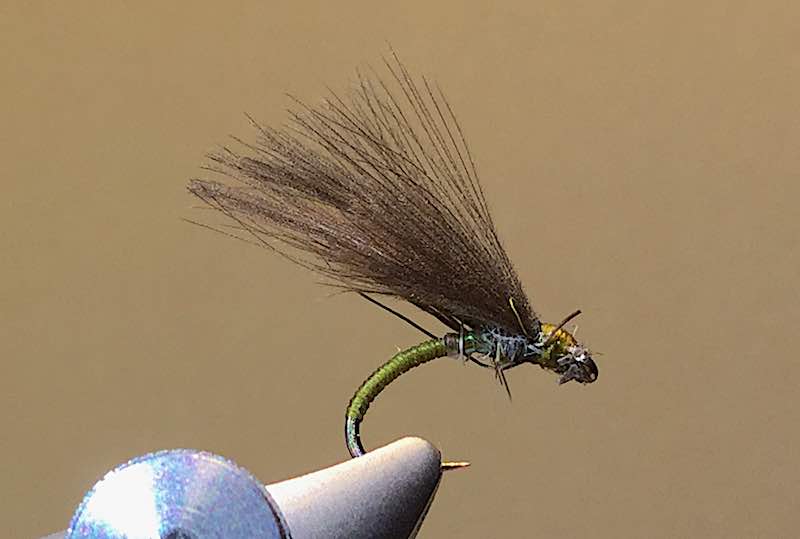
CDC Olive emerger
- Hook: Kamasan B100 #12 to 18
- Thread: Olive UNI-Thread 8/0
- Thorax: Hare’s ear dubbing
- Wing: 3-4 CDC feathers
To imitate a spring hatch of LDO, I use either a size 14 or 12. However, a size 16 or 18 is better for an autumn hatch, especially when fishing for grayling.
If the above fails, my backup is a…
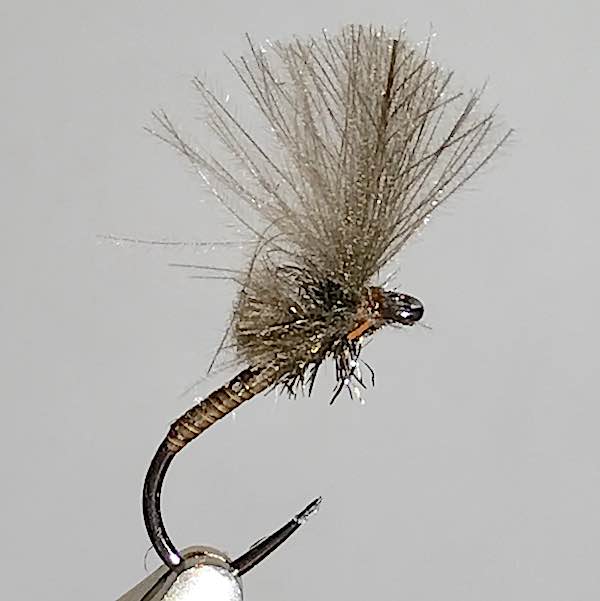
Olive Quill Emerger
- Hook: HENDS BL354 #16 & 18
- Thread: Tan UNI-Thread 8/0
- Body: Peacock quill
- Thorax: Peacock Herl
- Wing: 3 CDC feathers
If you’re unable to tie or get hold of the above patterns, then a traditional shop-bought Greenwell Glory dry fly (size 14) is a good general representation of the LDO and will catch early-season brown trout.
Large Dark Olive Spinner
The female LDO spinner has a reddish-brown body with olive rings and transparent brown-veined wings. After mating, she will lay her eggs in the river by crawling down partly submerged rocks and bankside vegetation.
As such, spinners are often of little significance to the fly fisher.
However, when trout are spotted taking spinners, they can be tempted with a size 14 pheasant tail spinner.

Pheasant tail spinner
- Hook: HENDS BL354 #14 & 16
- Thread: Olive UNI-Thread 8/0
- Tail: Ginger cock
- Tag: Pearl Mylar
- Body: Pheasant tail fibres
- Rib: Fine gold wire
- Wing: Cream Antron
Finally, I hope you have found this article on the large dark olive interesting, and if you want to practice this learning, there are some excellent fly fishing day ticket waters on the Welsh Dee.
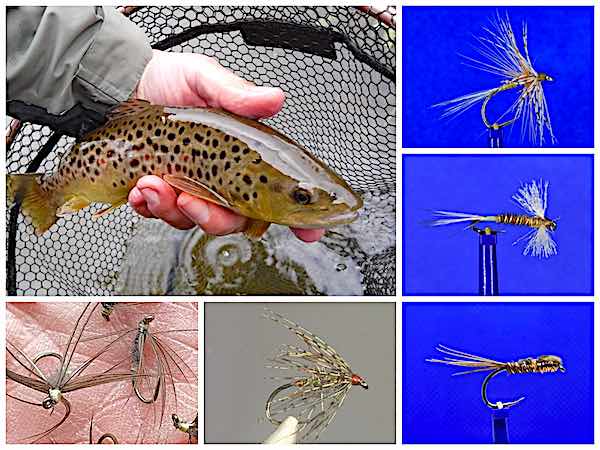
Great reading, thank you..
Great to hear you enjoyed it.
Many thanks for taking the time to post this fantastic information. As a newcomer to river fishing this is a great starting point for me. I will be busy at the vice getting the above patterns ready for the new season on the Dee. Cheers.
Hi Jamie,
Thanks for the feedback on my post – it’s great to hear you are finding them useful.
Cheers, Andrew
Very informative just the kind of thing that most blogs miss out
Hi John,
Thanks for the feedback and I’m glad you enjoyed the post.
Cheers, Andrew
Excellent, all I can say really.
Thanks
Absolutely brilliant
Cheers.
Fantastic reading.just what I was looking for.thanks for dedicating your time to enlighten other anglers like myself.
Hi Greig,
Thanks for the feedback. I’m pleased you enjoyed the article.
Cheers, Andrew
Thanks for this, very valuable and succinct. I don’t tie my own flies unfortunately and can’t foresee this happening due to other pressing commitments, so I wonder who you would recommend I buy from?
with thanks, Tony
Hi Tony,
Try https://www.yorkshire-dales-flyfishing.com/dry_flies.htm
I hope this helps, Andrew
Thanks especially for your posts, they are a real help!
Great to hear that.
Excellent thanks. I shall be fishing the Annan but your advice will be put to good use.
Hi Steve,
Good luck and it would be great to know which flies work best for you on the Annan.
Cheers, Andrew
Really good article ,plenty of useful tips . Cant wait to try them out . Been tying the flies you recommended ,won’t be long now !!
Hi Alan,
Great to hear you found it useful and I hope it helps you catch a few fish.
Cheers, Andrew
Thank you Andrew. I recently retired in Pennsylvania, having grown up in Ireland swinging wet flies these remind me of nicer versions of flies I tied as a wee lad. Great to see your beautiful flies. Recently only been tying pergedons, stone flys and streamers I’m looking forward to tying drys again. Have to say I’m disappointed in how British isles and Ireland manage waters I fished freely as a young man now with daily beat fees. I’m lucky to live in Pennsylvania with a lot of great public trout water that only requires one state licence. As I now spent summers in Ireland, joined one club and only have 1.5 Mike’s of water! Also as temps rise and pressured fish we should encourage no fishing days and much more C&R on fishing days. One river I fish is C&R only (no stocking all wild fish) for miles and then a small section is a two trout bag limit, but the trout can only be between 8-12”, encourages more C&R and ensures the big trout grow bigger. Difficult to find small fish there as most exceed 14” Fantastic fishery…we have a large green drake hatch in May that brings up monster trout for dry flies, it’s amazing to see 20” + browns take drys from the top.
Thanks again, I’m off to tie a few dries.
Hi John,
Thank you for the feedback on the post and it’s great to hear you enjoyed it.
Good luck with your fly tying. Cheers, Andrew
Hi just tying olive cdc emerger yours looks better will try a bit harder. Les
Hi Les,
They get better with practice but I’m sure the fish are not that bothered.
Cheers, Andrew
Hi Andrew,
As always a very informative post especially with all the tying instructions and locations where the LDO has been successful for you. I have just bought a new batch of CDC from Essential Fly at a very good price – 5 gms for £11.99 – outstanding. I hope that the weather in late February is mild enough to put some of the patterns to good use as I have a match on the Dee with PSUK anglers. Keep up with your excellent work in helping everyone to improve their skills. Tight Lines, Iain.
Hi Ian,
That is great value for CDC and will keep you tying for a while. At the moment it’s rain that is the problem. The Dee has been in flood and unfishable since the start of the new year. It needs at least a week of dry weather so the river can drop off to a fishable height. I hope that happens before your trip.
Tight lines, Andrew
Very informative reading good selection of flies too, I always like to fish with a nice shrimp or grub pattern too before the hatch.
Hi Steve,
Great to hear you enjoyed the article and thanks for your comments.
In spring I often start by euro nymphing and switch when I spot flies emerging.
Tight lines Andrew
Thanks ever so much Andrew for these invaluable insights into the Dee – please don’t stop!!
Hi Steve,
It’s great to hear you find them invaluable. I have quite a few more posts planned so you will have more to enjoy.
Thanks for the valuable feedback. Tight lines, Andrew
Probably the most informative source of information for the Welsh Dee, well done
Hi Graham,
Thanks for the great feedback.
Cheers, Andrew
Great information Thanks for that.
Hi Sean,
Great to hear you are finding the post useful.
Cheers, Andrew
As also great and useful info
Great to hear you enjoyed it. Cheers, Andrew
Very useful and informative post. Thank you Andrew. Tight lines.
Thanks, Andrew
Really enjoyed reading your article. Loads of tying to done in February so. Many thanks
Hi Tom,
Great to hear you enjoyed it. I hope all your tying produces so nice grayling and trout.
Tight lines, Andrew
Excellent work on all your posts etc.
Thanks.
I find myself engrossed in the magical world of fly fishing quite unexpectedly. Reading Bill Bryson’s ‘At Home’ I came across a mention of Greenwell’s Glory. My internet search led me here. Completely ignorant of your delicate art, I’m delighted with this introduction.
A treat indeed, thank you
Great to hear you enjoyed it.
Excellent advice,as always!
Thanks Andrew
Hi Steve,
Great to hear you enjoyed it.
Thanks for the feedback, Andrew
The next month I’m fishing on the Dee! Pierre Van Hecke – Belgium
May is usually a good month on the Dee because the trees are in full leaf and insect life is good.
Tight lines, Andrew